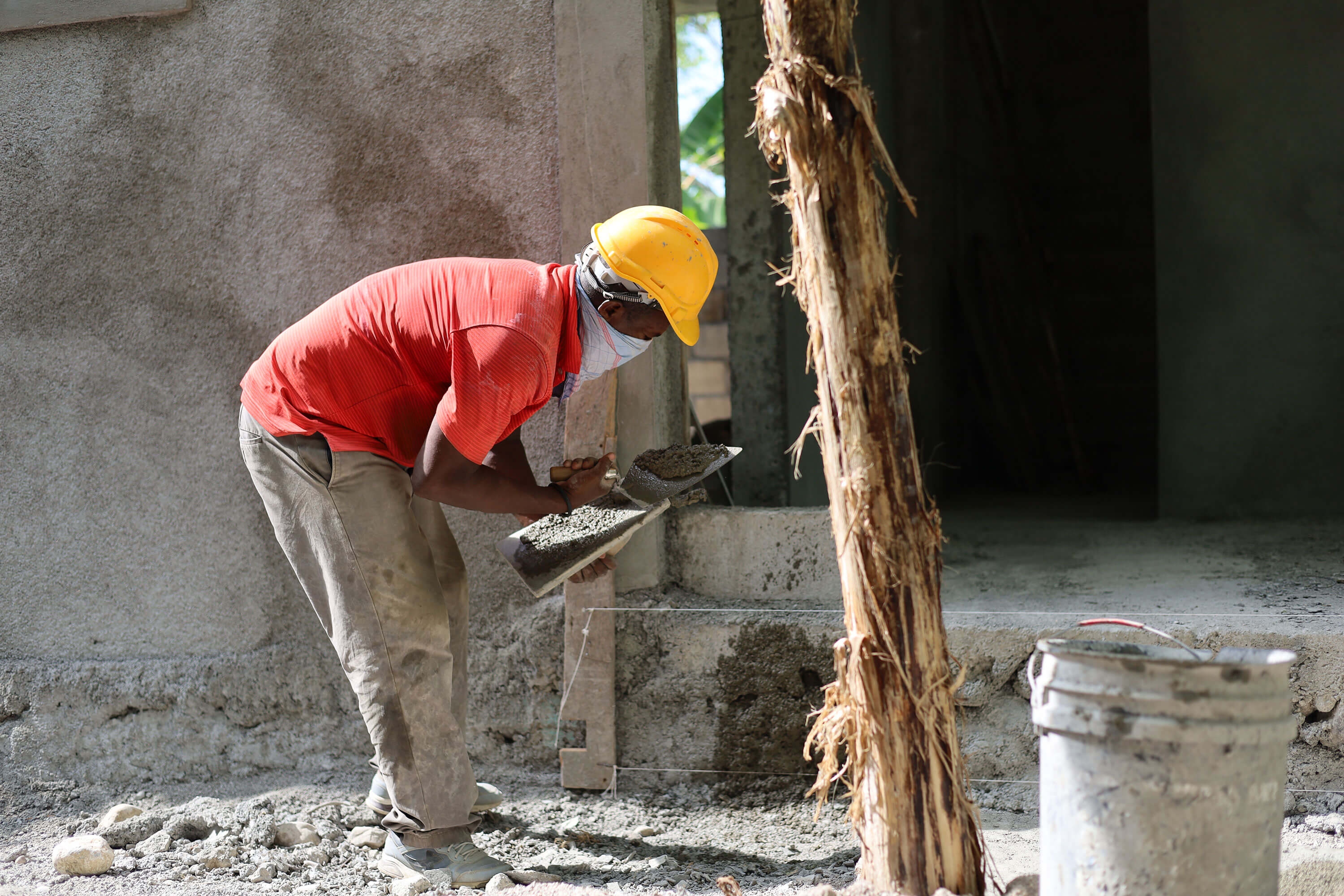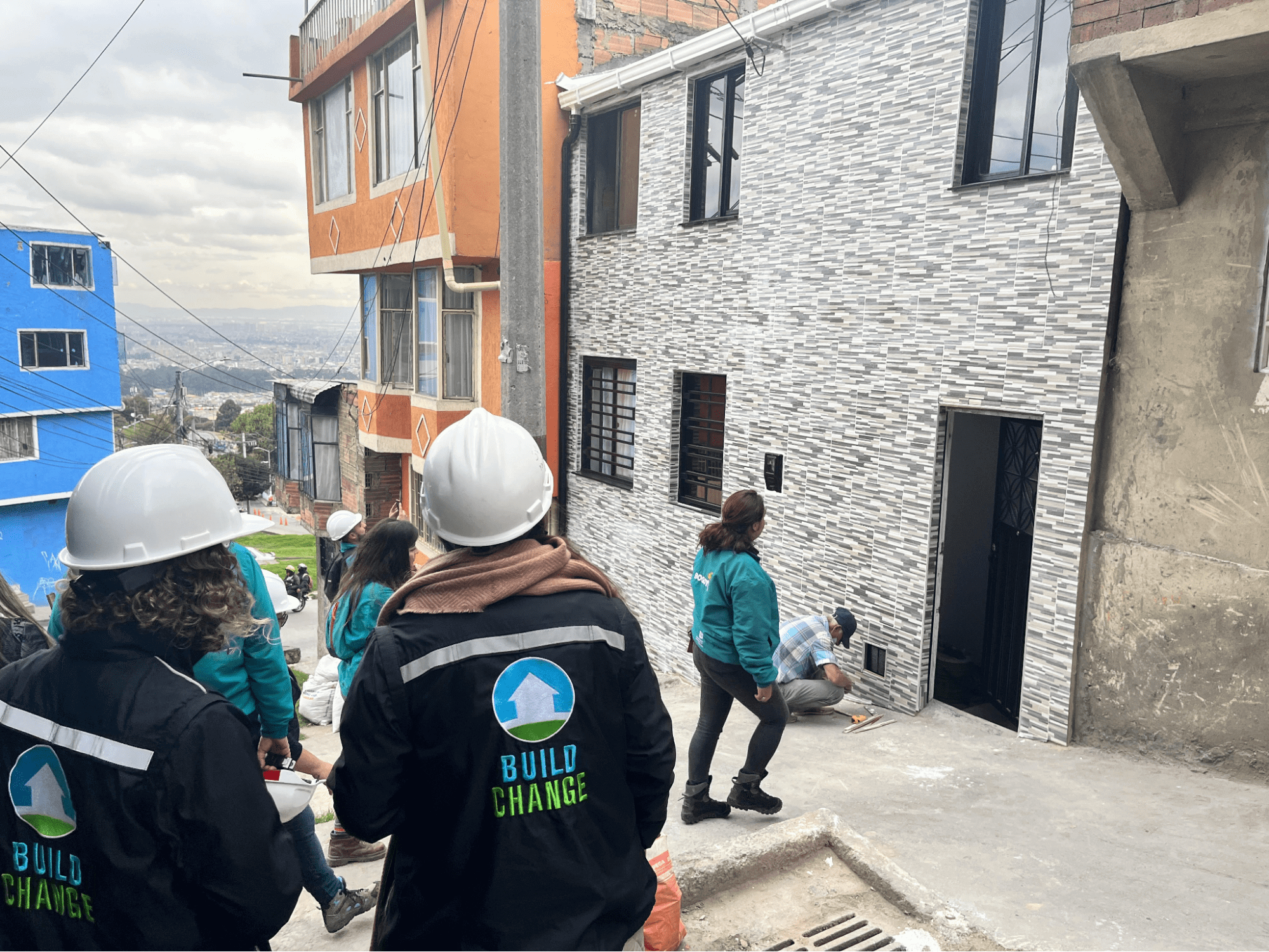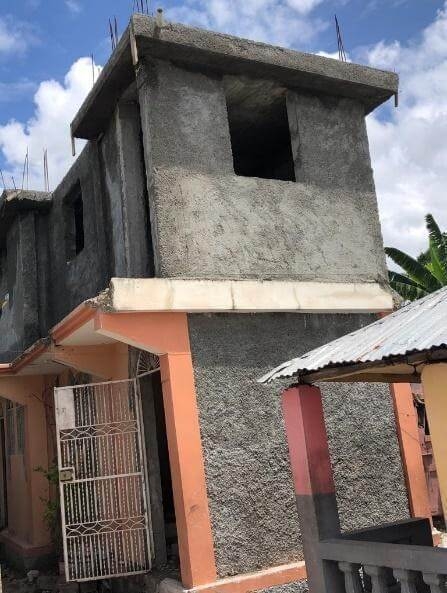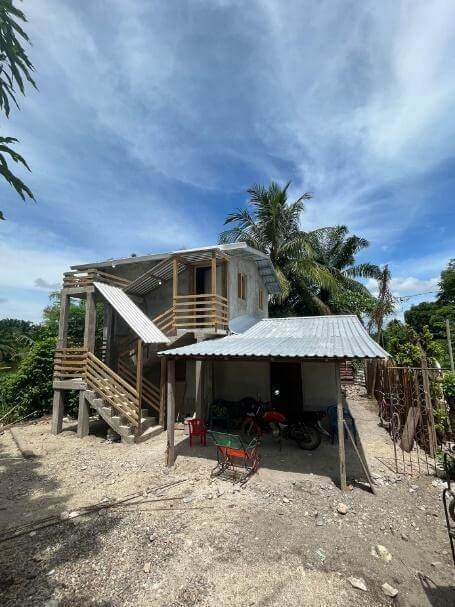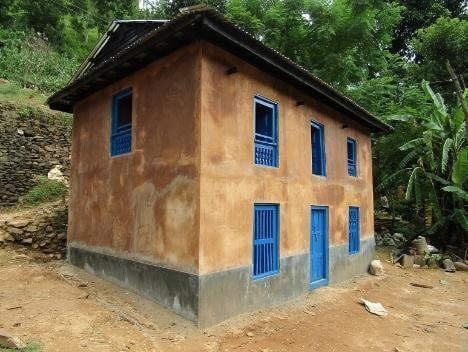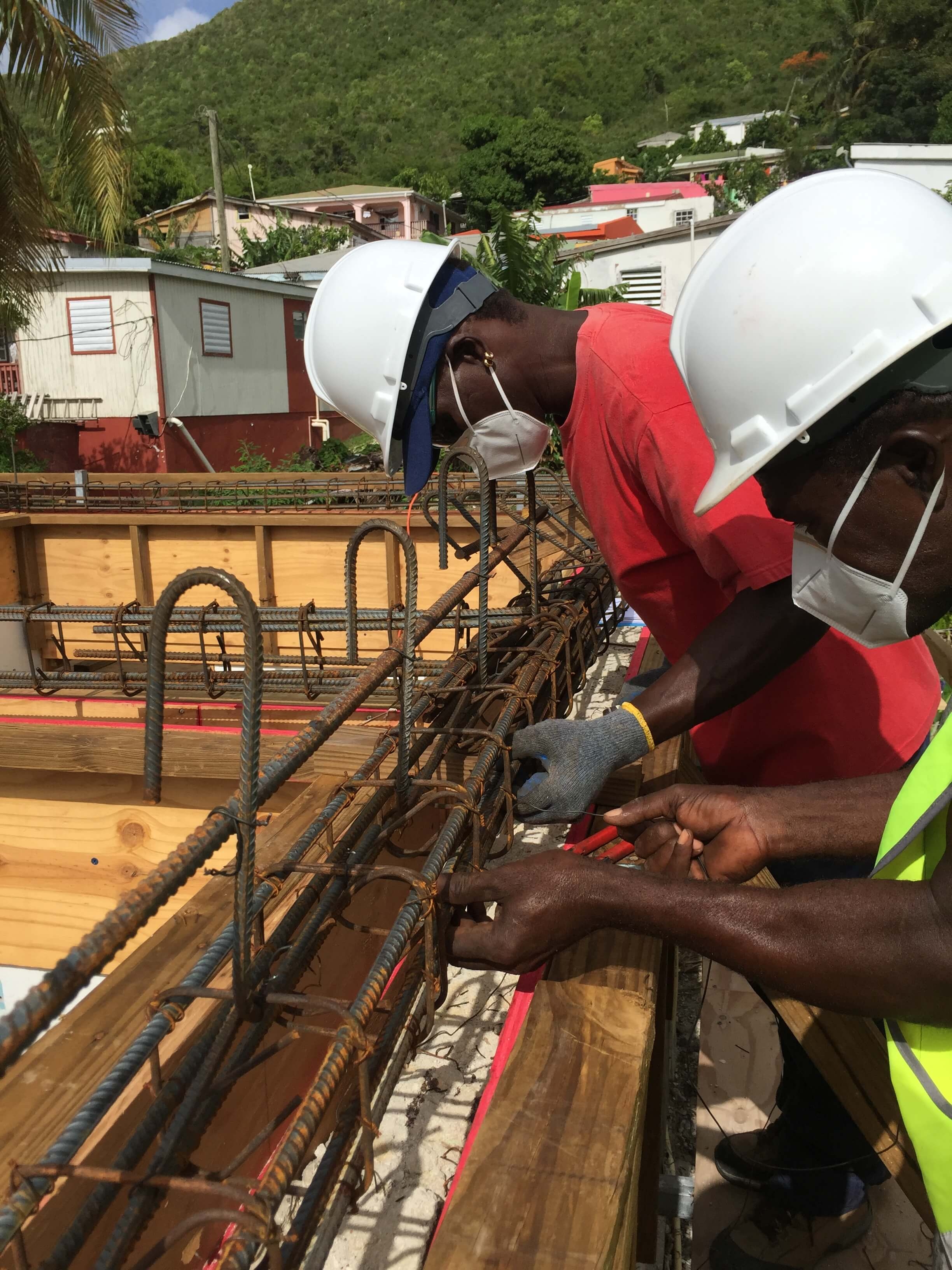Preface
Build Change is the global leader for systems change in resilient housing. For almost two decades, we have been working to protect people and their livelihoods by preventing housing loss caused by disasters and climate-induced events. We work to transform the systems for regulating, financing, building, and improving houses around the world. Since 2004, Build Change has made over 1 million people and 200,000 buildings safer in over 25 countries.
The people we work with, from homeowners to policymakers and housing financiers, are already experiencing the catastrophic effects of climate change. They are facing more frequent windstorms, a higher proportion of which are more severe, and more intense rainfall with higher flood levels.
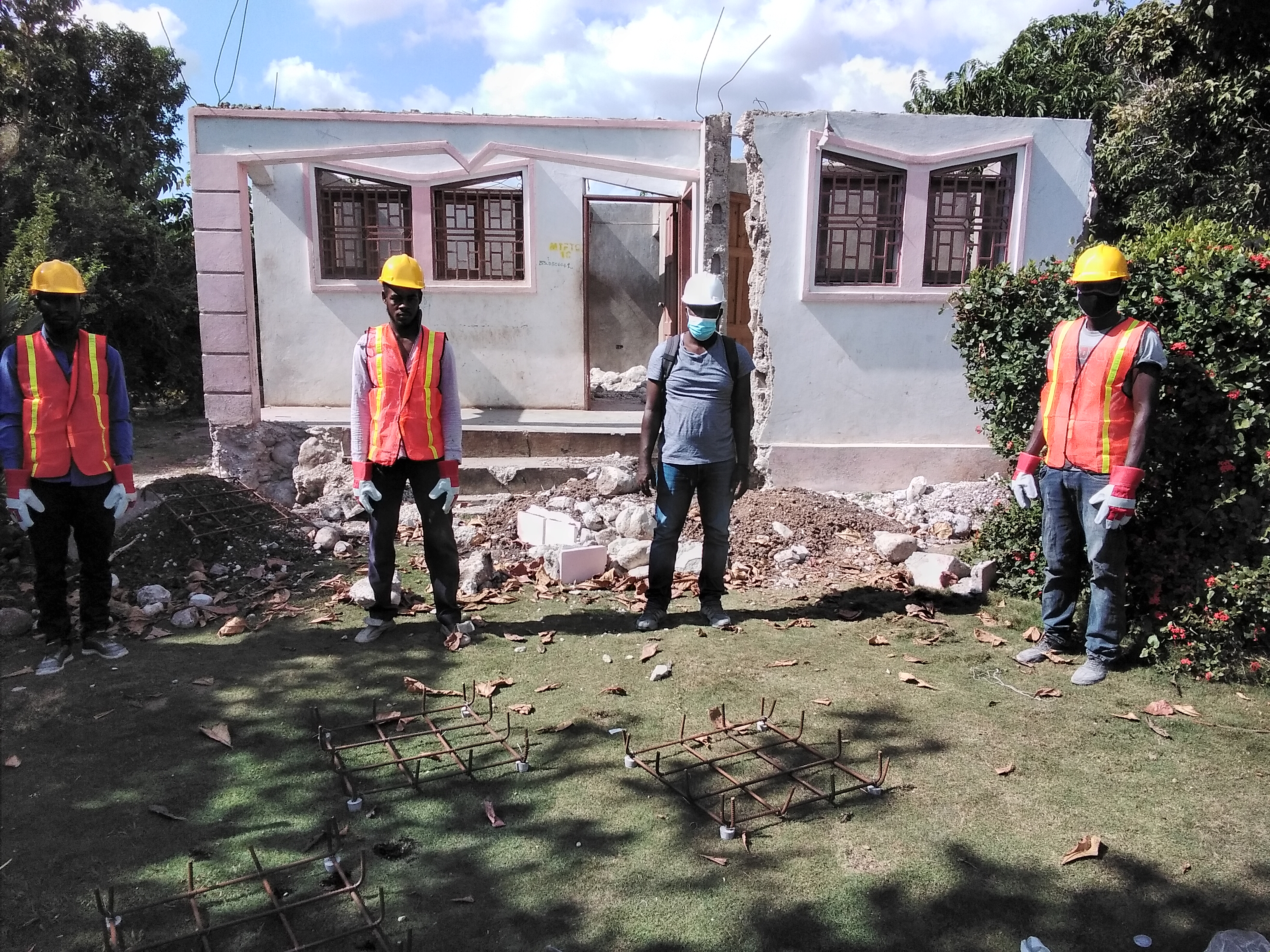
Adapting housing to be more resilient to climate change is an essential part of human survival of the climate crisis. But, in addition to adapting to the reality of climate change, we also want to minimize and slow the impact housing has on contributing to the causes of global warming.
Build Change first began working with governments, implementation partners, and homeowners to reuse and improve existing housing in Haiti following the 2010 earthquake near Port-au-Prince. The success of the program led us to apply the same approach to our other programs around the world and focus on improving housing that already exists, rather than building new.
Our experience in improving existing housing and the many benefits of doing so through homeowner-driven implementation models are documented in two existing Build Change publications:
- The Build Change Guide to Resilient Housing, an operational manual with case studies written to communicate our model for making housing resilient and to serve as a practical guide for those who work in pursuit of this goal.
- The Cost of Improving Vulnerable Housing, a comprehensive analysis of the cost of improving vulnerable homes, drawing on close to 1,500 retrofit designs from housing in fourteen countries across Asia, the Pacific, Latin America, and the Caribbean.
Recently we have begun to ask ourselves if we could quantify the environmental benefits. Could we apply established methods for calculating the emissions associated with building materials and construction to the post-disaster contexts in which we work? Could we do the same for preventative housing improvement programs in informal settlements?
The impetus of this study was to answer these questions. The subsequent analysis of our existing data sets has produced a number of important findings and recommendations that we use internally to inform decision-making by our engineers and designers, and externally to better communicate to homeowners and program partners the environmental benefits of improving existing housing. Above all, we want these findings to contribute to the global understanding of the benefits of reusing existing housing by providing data from novel contexts: post-disaster reconstruction and disaster prevention programs for self-built housing in informal settlements.
This report distills these findings into the third in our series of Build Change publications on improving existing housing. It presents the environmental benefits of upgrading existing housing rather than building new, based on analysis of the data set we have developed of our housing improvement programs in six countries around the world.
Executive Summary
The most sustainable house in the world is the home that has already been built. Assuming, of course, that the house has been made disaster-resilient.
Buildings and construction together account for almost 40 percent of energy-related carbon dioxide emissions, with housing accounting for at least 17 percent of the total.[1] While the benefits of retrofitting housing have long been known for increasing homeowner satisfaction, reducing construction-related costs, and strengthening local economies, little attention has been given to the environmental impact of a housing improvement intervention.
For housing built in informal markets, that is, housing constructed outside of regulation and government oversight, this study answers the question: how much embodied carbon can be saved by improving houses for disaster resilience?
This publication is the latest in a series authored by Build Change on strengthening and upgrading existing housing. Published in 2021, The Build Change Guide to Resilient Housing: An Essential Handbook for Governments and Practitioners serves as an operational manual and series of case studies in the operationalization of resilient housing programs. The Cost of Improving Vulnerable Housing, published in 2022, outlines the cost benefits and savings associated with improving existing housing for resilience.
As the third in this series, and informed by cases drawn from Build Change’s work in Colombia, Haiti, Honduras, Nepal, Philippines, and Sint Maarten and a total of 335 built projects, Saving Embodied Carbon Through Strengthening Existing Housing provides compelling evidence that improving existing housing significantly avoids carbon emissions in the housing construction value chain, thereby having substantial implications for achieving net zero in the built environment. By applying the findings from this study, we estimate there's an opportunity to save 4.8 gigatons of CO2 emissions while addressing the more than 268 million inadequate houses[2] globally.
Our intention is to contribute to global knowledge and research on the embodied carbon resulting from housing retrofits, upgrades, and improvements as well as new housing construction. In doing so, stakeholders across the housing value chain, including engineers and construction officials, policymakers, financiers, and advocates, can advance sustainable solutions to reduce the qualitative housing deficit and ensure provision of resilient housing.
Key findings include:
Improving a house instead of building a new one saves two-thirds of embodied carbon of an equivalent new house, and, on average, saves 18 metric tons of carbon dioxide. For the same embodied carbon budget of one new house, more than three houses can be improved and made safer.
Even if vertical expansion is included in the intervention, creating an additional living space or unit, it is still more carbon-efficient to improve existing housing rather than build new. With vertical expansion (e.g. adding a second story), improving existing housing still uses, on average, 47 percent less embodied carbon than an equivalent new house, meaning that the savings are doubled.
It is more carbon-efficient to improve an existing house before a disaster—even when the house is also expanded—than wait until it is destroyed and has to be rebuilt. Embodied carbon savings for a preventative upgrade are, on average, 61 percent higher than a post-disaster upgrade (without expansion). When the house is also expanded vertically, savings are still 26 percent higher if the upgrade is done preventatively.
Figure 1: The Costs of Inaction
Policymakers play a critical role in shaping the regulatory environment for prioritization of embodied carbon reduction in the housing sector through retrofitting. Based on the findings from this study there are a number of important actions that can be taken to advance overall resilience and embodied carbon savings in the housing sector. Most critically, these include:
Retrofit houses to withstand disaster. Policymakers should prioritize retrofitting existing housing as an effective strategy for both climate change adaptation and mitigation. The best way to balance the urgent needs for more housing, resilient housing, and green housing, while minimizing greenhouse gas (GHG) emissions, is to upgrade the existing housing stock.
Act now! Governments and homeowners should retrofit preventatively, before a disaster, to save even more emissions. The additional materials required for building repair in post-disaster scenarios significantly increases the emissions. Policies should incentivize mitigation before the next disaster.
Advance actions which prioritize housing upgrades within climate commitments, such as NDCs or building sector roadmaps, as well as national urbanization frameworks. With the next round of updates to Nationally Determined Contributions (NDCs) in 2025, the moment is ripe for integrating ambitious goals into climate planning. Governments should include housing upgrade plans within national frameworks for urban development and climate mitigation and adaptation, as well as within provisions for incremental upgrading within building codes. Advancing data through this study, and subsequently promoting action and leadership to reduce embodied carbon in the built environment—and in housing specifically—will be critical to shape the future of mitigation efforts, as well as provide the housing needed to meet the increasing requirements of a changing environment and global population.
1.0 Introduction: Two Conflicting Global Challenges
Globally, we need more housing—and we need better housing.
UN-Habitat estimates that 40 percent of the world’s population will need access to adequate housing by 2030, which translates into a demand for 96,000 new housing units every day.[3] Growing populations are driving a need for more housing in absolute terms. This is particularly true in cities, because of unceasing rural to urban migration.
This quantitative deficit goes hand in hand with the qualitative housing deficit, meaning there is an equal or greater need to improve the units that already exist. For example, neighborhoods may need connection to fresh water and sanitation infrastructure, or buildings may need to be strengthened and improved to better withstand earthquakes and climate extremes.
A critical component of reducing the qualitative housing deficit is increasing disaster resilience. Natural hazards alone do not cause disasters. Disasters develop when a natural hazard occurs in a location of high population exposure, and are exacerbated by social, financial and environmental vulnerabilities. The many barriers to resilient housing, including those caused by policy, money, and technology, mean it is common for housing to have been inadequately designed or built to resist natural hazards. Seventy-seven percent of fatalities from the deadliest earthquakes in the last 100 years were due to the collapse of masonry structures.[4]
Unfortunately, the risk from natural hazards is not static. Climate change is creating new hazards, exacerbating existing ones,[5] and multiplying the exposure to hazards.[6] Furthermore, the growing climate risk does not affect all people equally. Countries and populations with minimal historical emissions—such as small island developing states and indigenous communities—are disproportionately affected by the adverse effects of climate change,[7] resulting in serious threats to their homes.
We also need to significantly reduce both the embodied and operational greenhouse gas emissions associated with housing.
The UN Environment Global Status Reports conclude that buildings and construction together account for almost 40 percent of energy-related carbon dioxide emissions, with housing accounting for at least 17 percent of the total (See Figure 2).[8] To meet global climate ambitions set out in the Paris Agreement, the global buildings and construction sector must almost completely decarbonize by 2050. The energy intensity per square meter of the global buildings sector needs to improve on average by 30 percent by 2030 (compared to 2015).
At the same time, Dr. Fatih Birol, head of the International Energy Agency, recently noted that the world is expected to build 230 billion square meters of new construction over the next 40 years—adding the equivalent of the city of Paris to the planet every single week.[9]
Figure 2: Share of global energy-related CO2 emissions by sector
Source: United Nations Environment Programme
Emissions associated with buildings and construction are split into two groups: embodied carbon emissions and operational carbon emissions.
To date, the global focus has been to prioritize reductions in operational emissions from buildings and construction, a logical initial response when operational emissions have traditionally accounted for a higher proportion of total emissions. Globally, investment in the energy efficiency of buildings is rising, reaching more than USD 180 billion in 2020—a 40 percent increase since 2015.8 Regulation is also increasing: 63 percent of countries now include measures for energy efficiency improvements in buildings as part of their Nationally Determined Contributions and 81 countries now have mandatory or voluntary building energy codes (compared to 62 countries in 2015).[10]
However, because focus has been on operational instead of embodied carbon emissions, embodied emissions now account for a much larger proportion of total building lifetime emissions. In some countries,embodied carbon may soon approach 100 percent of the total and can already account for 40–70 percent of whole life carbon in a new low-carbon building.[11]
How do we balance the needs for more housing, resilient housing, and green housing?
The urgent need for more and better housing often appears to be at odds with demanding schedules for emissions reductions targets in buildings and construction. Adequate housing is an essential precursor for economic prosperity, health and wellbeing, and equitable development. But if no changes are made to housing production, the environmental cost of providing for such a large proportion of the global population will be disastrously high.
Inherent to disaster-resilient housing is resistance against damage from natural hazards such as hurricanes, floods, fires, and earthquakes. However, the additional demands these kinds of loads place on a structure are not immediately complementary to efforts towards lower carbon, more efficient design. There is growing evidence that when the full life cycle and life span of a building is considered, it is neither sustainable nor economical to build structures that will be damaged beyond repair during expected hazard events, and thus require complete replacement with new building materials.
Box 1: Embodied Carbon and Earthquakes in New Zealand. Following the 2010-2011 Canterbury, New Zealand earthquakes, 60 percent of multistory buildings in the Christchurch central business district were demolished. Using a dataset of 142 demolished concrete buildings, researchers at the University of Auckland found that the total embodied carbon, now beyond reuse and deposited in a landfill, was equivalent to the emissions from the electricity purchased by 20 percent of the dwellings across the country in a year.[12]
Harnessing the potential of “Build Less”
In the Hierarchy of Net Zero Design (see Figure 3), enormous potential exists to reduce embodied carbon in the built environment by applying the “Build Less” approach to housing. This category, which has the second highest potential to create savings next to “build nothing”, includes repurpose, refurbish, and reuse. Strengthening and improving an existing home to withstand disaster fits perfectly in this category.
Figure 3: The Hierarchy of Net Zero Design
Source: IStructE (IStructE, 2022)
2.0 Overview of the Dataset and Analysis Approach
This report presents a first-of-its-kind international data set on the embodied carbon savings impacts of improving existing housing to withstand disaster.
The dataset spans six countries across four continents. The embodied carbon savings are estimated by comparing 275 existing home strengthening projects with 60 new disaster-resilient housing projects in the same countries. All 335 homes have been built or retrofitted by Build Change or our partners, meaning the analysis was based on the final, measured quantities of materials that went into each house.
Comparing the home retrofits against disaster-resilient new construction was the favored approach for a number of reasons:
-
In most cases, new construction is the most likely alternative to retrofitting. In both post-disaster and prevention contexts, the misperceived challenges of improving existing housing most often result in governments, the private sector and aid agencies opting to build new rather than improve existing housing.
-
The relative approach standardizes the results and allows compilation and comparison at a global scale. Build Change’s retrofit interventions vary considerably depending on the local context, but by always comparing the retrofit to an equivalent new construction we are able to aggregate the results and draw global conclusions.
-
Considering the results relative to a baseline addresses many of the challenges of uncertain or absent data. In the countries highlighted in this study, there is a scarcity of data on embodied carbon of building materials. By using the same data for emissions calculations of retrofit and new construction houses, this analysis ensures that the emphasis is on the difference between the two scenarios.
Our analysis considers the “upfront carbon”, referred to as lifecycle stages A1 to A5 in Figure 4, for both the retrofit homes and the new construction homes. Whether a home is disaster resilient because it was retrofitted or newly built does not significantly impact the emissions associated with the use and end-of-life phases, so the emissions associated with stages B and C are canceled out when comparing retrofit with new construction.
Figure 4: Building Life-Cycle Assessment Phases
Source: RMI
To account for differences in the data sample size from different countries, the houses were grouped into 16 different design groups. Every house within a design group shares key characteristics, such as location, construction type, performance target, hazards considered, and disaster context. Sample designs within the same design group were averaged to determine an overall representative set of carbon costs for each group.
Figure 5: Countries and Their Respective Sample Size (Number of Houses) Represented in Dataset

Source: Build Change
3.0 Key Findings
Improving an existing house, instead of building a new one, saves 18 metric tons of carbon dioxide.
On average, 18 metric tons of carbon dioxide are saved per house.
This is more than one person’s total annual emissions in the US or 60 people’s total annual emissions in Haiti.[13]
Figure 6: The Relative Cost of Embodied Carbon Savings in a Single House
Source: Build Change
Each home improved saves over two-thirds of the embodied carbon generated by an equivalent new house.
Reusing and improving existing housing is a way to balance the urgent need for more, better quality housing with greenhouse gas emissions reductions. Strengthening existing housing uses just 32 percent of the embodied carbon of an equivalent new house on average. This means that for the same embodied carbon budget of one new house, three houses can be improved and made safer.
Figure 7: Average Embodied Carbon in Home Improvements, Relative to Equivalent New Construction
Even if vertical expansion is included in the intervention, it is still more carbon-efficient to improve existing housing rather than build new.
With vertical expansion to create an additional living space or unit (e.g. a second story), strengthening existing housing still only uses 53 percent of the embodied carbon of an equivalent new house. In cases where the expansion creates an additional housing unit, the savings are doubled.
For many homeowners with limited financial resources, strengthening their home for increased hazard resistance takes a lower priority than habitability improvements or meeting the daily needs of their family. Incentives—such as the safe addition of a second story—are often integral to reaching wide-scale adoption of home improvement programs. At a wider scale, vertical expansion of homes increases the supply of available safe housing and supports urban densification, which minimizes land consumption, increases the operational energy efficiency of housing units, and reduces emissions from transportation.
Figure 8: Average Embodied Carbon in Home Improvements with Vertical Expansion, Relative to Equivalent New Construction
It is more carbon-efficient to improve an existing house before a disaster than after—even when the house is also expanded.
Post-disaster home improvements typically use a lot more material for repairs. As a result, the embodied carbon savings for a preventative upgrade are on average 61 percent higher[14] than a post-disaster upgrade (without expansion). When the house is also expanded vertically, savings are still 26 percent higher if the upgrade is done preventatively.[15]
Figure 9: Emissions Savings by Intervention Type and Timing
Improving a home preventatively, before a disaster, also has considerable financial and social benefits. In 2021, Build Change published the findings from a detailed cost analysis of global projects, which used much of the same data as this embodied carbon analysis. It found that the construction costs to improve existing houses were approximately 1.6 times lower, on average, in a prevention context than in a post-disaster context, and the amount spent on structural condition repairs was almost six times less before a disaster than after.
Not all home improvements are equal—the emissions associated with interventions vary depending on several factors.
The Build Change Guide to Resilient Housing details with numerous examples the many considerations when designing a home improvement program, of which minimizing embodied carbon is unlikely to be the top priority to key stakeholders. However, the decisions made at the start of a housing program can have a significant impact on the overall emissions savings. The embodied carbon associated with home improvement interventions depends on many factors, and an appreciation of how decisions impact the potential emissions savings is an essential first step.
As the last two findings have shown, the emissions savings depend on the:
-
Timing, whether performed preventatively or post-disaster
-
Scope of the intervention, particularly if vertical expansion is desired (see Colombia, Haiti, and Honduras case studies for more details).
The detailed case studies show how a number of other factors can influence the extent of emissions savings, including:
-
Condition of the existing building, including damage due to lack of maintenance
-
Quality of the existing design and construction, which influences the number and type of strengthening interventions required in the retrofit (see Haiti and Sint Maarten case studies)
-
Materials of existing building, as often these limit the materials of the retrofit intervention (see Nepal case study)
-
Design criteria, including the hazards, and desired or required performance level of the building against those hazards (see Sint Maarten case study)
-
Homeowners’ preferences, in particular the type of roof (most often choosing between a concrete flat slab roof or a pitched, timber framed roof), but also their decisions on features such as non-structural plaster (see Colombia case study)
-
Location, which affects the source and transportation of retrofit materials (see Philippines case study)
Interestingly, the size of the house (measured by floor area) was not a significant factor in the emissions of an improvement intervention. This is thought to be because larger houses are often first designed and built to higher standards, and it means that larger houses should not be precluded from strengthening programs solely on the basis of their size.
The impact of these factors can be seen in the embodied carbon emissions savings from Build Change home improvement programs, which varied between 42 percent and 75 percent as compared to new construction.
Figure 10: Home Improvement Emissions by Program, Relative to New Construction
The highest savings of 75 percent were for one of the Sint Maarten design groups, where program design criteria meant that the majority of the homes were strengthened for risk reduction rather than a full life safety performance level. The condition and materials of the existing houses were also typically of higher quality than in other countries.
The lowest savings of 42 percent were in Haiti for the vertical expansion design group. The condition and quality of the existing buildings were poor, the design criteria relatively stringent due to the very high seismic and hurricane risk, and the scope of the intervention included vertical expansion.
For further details on Sint Maarten, Haiti, and all other country programs, see the Detailed Country Case Studies.
Cement and steel account for 60 percent, on average, of all home improvement emissions.
Build Change’s structural home improvements are typically limited to only six or seven principal materials based on the common locally available skills and materials where the programs have operated. These are concrete, consisting of cement, sand, gravel, and water; steel reinforcement; masonry units, most commonly fired clay or concrete blocks; metal roof sheets; and timber or hollow steel sections for roof framing. However, Figure 11 shows that the emissions associated with these materials are far from equal. Averaging emissions across the six countries, steel and cement account for over 60 percent of embodied carbon emissions.
Figure 11: Average Emissions From All Countries By Material
In each country, cement and steel account for at least 40 percent of all emissions. Figure 12 shows how in countries where concrete block walls are prevalent, such as Haiti and the Philippines, cement and steel account for over 80 percent of embodied carbon emissions.
Figure 12: Average Emissions of Home Improvement by Material, in tons of CO2e and as a percentage of home improvement emissions
*Cement includes aggregates for Colombia and Sint Maarten; for all other countries aggregates are included under Other.[16]
Masonry is a popular building material for housing throughout the world. Homeowners opt for masonry homes for many reasons: the materials and labor are easily available on the local market, it is affordable, and it is familiar and part of the culture. Compared to other housing construction systems, masonry can have improved resistance to fires and to flying debris during wind storms; it can be more secure against intruders; and it has a higher thermal mass, which reduces thermal gain in hot climates and keeps families cooler.
However, when masonry houses are under-reinforced or unreinforced, such as those considered in this study, they are poorly suited to resist the effects of earthquakes and windstorms. 77% of fatalities from the deadliest earthquakes in the last 100 years are associated primarily with the collapse of masonry structures.[17]
Strengthening vulnerable masonry houses typically requires the use of reinforced concrete (which is made from cement and steel reinforcement, as well as other materials) as it improves structural performance while also being affordable to homeowners, available in local markets, and familiar to local builders.
4.0 Recommendations
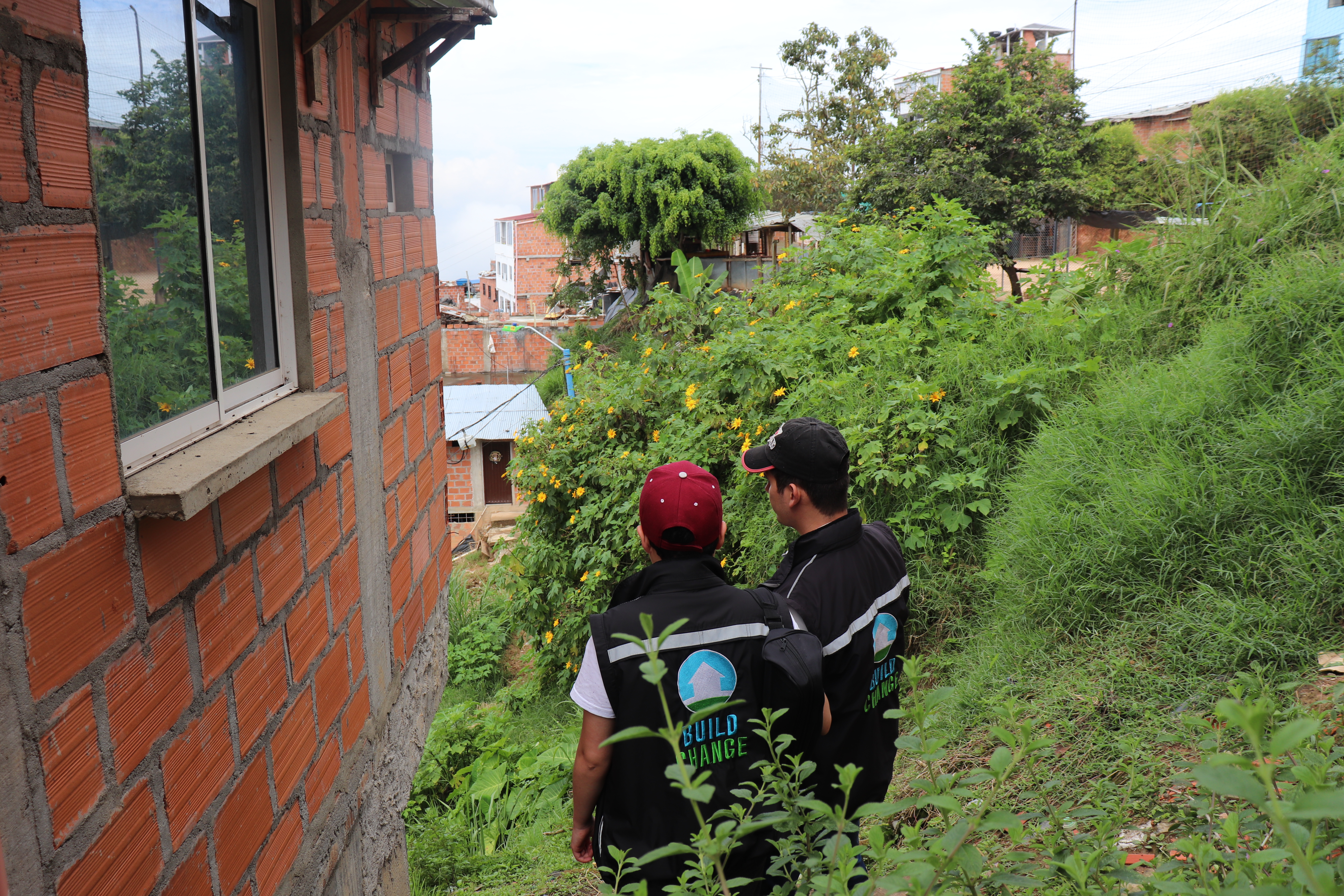
The recent focus on reduction of carbon in the built environment has centered primarily on reduction of operational carbon. While this remains critical to advance climate mitigation, the findings of this study contribute to increasing focus on embodied carbon reduction as an equally important solution for both climate mitigation and adaptation.
Policymakers play a critical role in shaping the regulatory environment for prioritization of embodied carbon reduction in the housing sector through retrofitting. There are a number of important actions that can be taken to advance overall resilience and embodied carbon savings in the housing sector.
Retrofit houses to withstand disaster.
Policymakers should prioritize retrofitting existing housing as an effective strategy for both climate change adaptation and mitigation.
The best way to balance the urgent needs for more housing, resilient housing, and green housing, while minimizing GHG emissions, is to upgrade the existing housing stock. Improving an existing house instead of building a new one saves over two-thirds of the embodied carbon generated by an equivalent new house. Even if the house is vertically expanded to add a new second story, it still only uses half the embodied carbon of an equivalent new house.
In addition to the emissions savings from retrofitting, there are also known to be significant cost savings. On average, in the 2022 study The Cost of Improving Vulnerable Housing, Build Change found the cost of retrofitting a house was 23 percent of the cost of building new in the same location.
Furthermore, a house does not have to be retrofitted to full building code compliance level to see benefits in terms of disaster resistance. Where legally permitted, risk reduction improvements can improve building safety at much lower financial and environmental costs: life safety interventions cost 17 percent more than risk reduction interventions[18] and, in Sint Maarten, saved double the emissions.
Act now!
Governments and homeowners should retrofit preventatively, before a disaster, to save even more emissions.
The additional materials required for building repair in post-disaster scenarios significantly increases the emissions. For a house without expansion, the embodied carbon savings for a preventative upgrade are on average 61 percent higher than a post-disaster upgrade. In other words, waiting until after a disaster to retrofit a home reduces the savings by 1.6 times.
Financially, it is also significantly cheaper to retrofit preventatively rather than after a disaster: construction costs to improve vulnerable housing were found to be 1.6 times lower in a prevention context than a post-disaster context.[19]
Design retrofits appropriately and efficiently.
Engineers can increase savings generated through retrofitting existing housing by designing appropriately and efficiently.
For the masonry buildings that make up the large majority of structures considered in this study, the emissions from reinforced concrete far outweigh all other materials. However, completely eliminating the use of reinforced concrete in home strengthening interventions is not feasible. Reinforced concrete is frequently preferred by homeowners, and the only material readily and affordably available with which the local labor force already has the expertise to build resilient homes.
There are several ways that reinforced concrete can be used more appropriately and efficiently to support emissions reductions. Examples of appropriate design criteria include accurate determination of the hazard exposure and selection of an appropriate performance level. Designing efficiently can include:
-
Ensuring reasonable factors of safety are used and the building or certain elements within the building are not over-designed for the anticipated loads;
-
Considering, where available in the local market, the use of lower-carbon alternatives, such as partially replacing cement with substitute materials such as pulverized fuel ash (PFA) or ground granulated blast-furnace slab (GGBS) (or newer alternatives);
-
Maximizing use of the existing structure; and
-
Minimizing waste, for example by designing the building geometry to suit standard material dimensions.
Increase data available on embodied carbon in housing.
One of the major challenges in undertaking upgrading projects or retrofits within infrastructure, especially housing, is a lack of data around embodied carbon. This is particularly true in the Global South. Life cycle assessments (LCA) that quantify the potential savings generated should be introduced as an additional means to assess the relative benefits of different housing programs, both in post-disaster or preventative strengthening contexts. LCAs should be standardized and publically reported. This can serve as a useful resource for any publicly funded or subsidized upgrading projects to demonstrate the environmental impacts, as well as for investors into privately owned housing to demonstrate the overall positive impact of the investment. Homeowners would also benefit from this information as a choice tool to determine how they prioritize upgrade programs.
Advance actions which prioritize housing upgrades within climate commitments, such as NDCs or building sector roadmaps, as well as national urbanization frameworks.
Following on the heels of the Paris Agreement, the next decade will be critical in refining and addressing gaps in climate commitments. With the next round of updates to Nationally Determined Contributions (NDCs) in 2025, the moment is ripe for integrating ambitious goals into climate planning. Governments should include housing upgrade plans within national frameworks for urban development and climate mitigation and adaptation, as well as within provisions for incremental upgrading within building codes. Any commitments will require adequate investments via loans, public resources, grants, or other financing mechanisms, which should be reflected in planning processes.
Recognize the role of city and regional actors in upgrading housing.
Planning around housing upgrades is important for both national actors and sub-national governments, including regions and cities. Various mechanisms, such as city roadmaps, sector roadmaps, or other planning goals, should integrate a “retrofit-first approach” where appropriate, both to maximize efficient use of resources (see The Cost of Improving Vulnerable Housing) and reduce environmental impacts. This also requires adequate financing—through public and private sources—of these initiatives advanced by non-state actors, including city and regional actors, as well as other actors across the housing value chain.
Educate housing officials and decision-makers about the environmental impacts of retrofitting.
Organizations, including Build Change, have advocated for upgrading housing for decades. Educating housing officials about the environmental impacts of retrofitting is critical to ensure widespread adoption of retrofit-friendly policies and projects. Capacity-building programs for public sector officials should include information on the benefits of upgrading housing, including the environmental, cost, economic growth, and sustainable development benefits as an alternative to new construction projects.
5.0 Detailed Findings—Program Case Studies
References
- United Nations Environment Programme (2021). 2021 Global Status Report for Buildings and Construction: Towards a Zero-emission, Efficient and Resilient Buildings and Construction Sector. Nairobi ↩
- International Finance Corporation, World Bank Group, Introducing the Adequate Housing Index (AHI), A New Approach to Estimate the Adequate Housing Deficit within and across Emerging Economies (2021). https://openknowledge.worldbank.org/server/api/core/bitstreams/e3820a80-1028-5393-9500-c5e5ccf3976d/content ↩
- UN-Habitat, Housing (2022). https://unhabitat.org/topic/housing ↩
- The World Bank, Roadmap for Resilient Housing: The Path to Livable, Disaster and Pandemic Resilient Housing, (Washington, D.C.: Global Program for Resilient Housing, 2020).↩
- NOAA GFDL, Global Warming and Hurricanes: An Overview of Current Research Results (2023) https://www.gfdl.noaa.gov/global-warming-and-hurricanes/; Very intense refers to Category 4 or 5 levels.↩
- Carbon Brief. Mapped: How climate change affects extreme weather around the world (2022). https://www.carbonbrief.org/mapped-how-climate-change-affects-extreme-weather-around-the-world/ ↩
- UNFCCC, Small Island Developing States and Climate Change (2005). https://unfccc.int/resource/docs/publications/cc_sids.pdf↩
- The 2017 Global Status report, with data from 2015, concluded buildings and construction account for 39 percent. This dropped slightly to 37 percent in the 2021 report, with data from 2020. The reduction is noted to have been a temporary result of the COVID-19 pandemic, rather than a permanent reduction due to changing practices; United Nations Environment Programme (2021). 2021 Global Status Report for Buildings and Construction: Towards a Zero-emission, Efficient and Resilient Buildings and Construction Sector. Nairobi ↩
- UN Environment and International Energy Agency (2017) Towards a zero-emission, efficient, and resilient buildings and construction sector. Global Status Report 2017. https://worldgbc.org/wp-content/uploads/2022/03/UNEP-188_GABC_en-web.pdf ↩
- UNEP, 2021 Global Status Report for Buildings and Construction ↩
- IStructE (2021). Design for zero. The Institution of Structural Engineers, London, United Kingdom.https://www.istructe.org/resources/guidance/design-for-zero/ ↩
- Gonzalez, R.E., Stephens, M.T., Toma, C. et al. Incorporating potential environmental impacts in building seismic design decisions. Bull Earthquake Eng 21, 4385–4428 (2023). https://doi.org/10.1007/s10518-023-01686-y ↩
- 14.7 metric tons emitted per capita in the US, 0.3 metric tons emitted per capita in Haiti, 2019 data (World Bank, 2023) ↩
- Average savings for house upgrade post-disaster: 0.22 tCO2e/m²; average savings for house upgrade in a prevention context: 0.37 tCO2e/m². Does not include houses with expansion. ↩
- Average savings for improvement and expansion post-disaster: 0.14 tCO2e/m²; average savings for improvement and expansion in a prevention context 0.18 tCO2e/m². ↩
- In its simplest form, concrete is made by mixing cement, aggregates (sand and gravel), and water. For the houses in this study, concrete was made in two different ways. For the majority of houses, the constituent materials were purchased separately and mixed on site; for houses in Colombia and Sint Maarten, the concrete was mixed offsite at a batching plant and then delivered ready to be poured. When concrete is batched off-site, the emissions associated with the aggregates are reported together with the cement. Concrete aggregates typically account for a very low proportion of total home improvement emissions (2–5 percent). ↩
- The World Bank, Roadmap for Resilient Housing:The Path to Livable, Disaster and Pandemic Resilient Housing, (Washington, D.C.: Global Program for Resilient Housing, 2020). ↩
- The Cost of Improving Vulnerable Housing: Recommendations for Investments in Housing Resilience from an Analysis of Global Project Data. Denver, CO: Build Change, 2022. ↩
- ibid.↩
